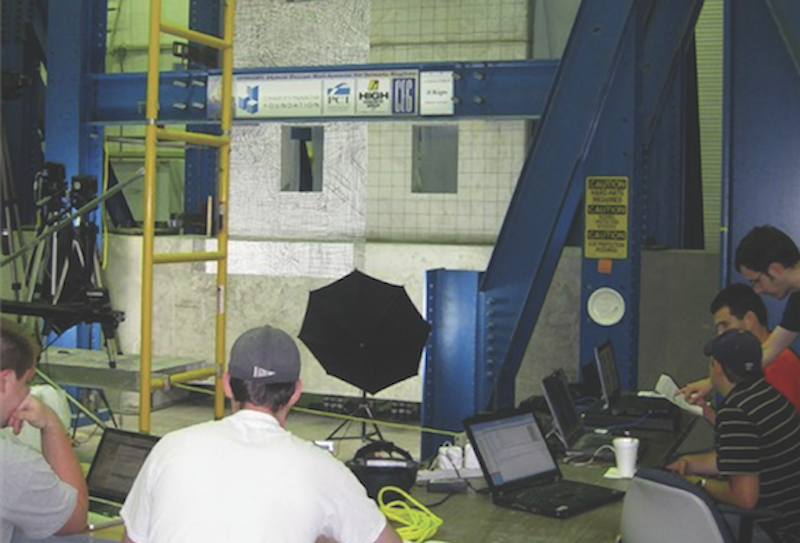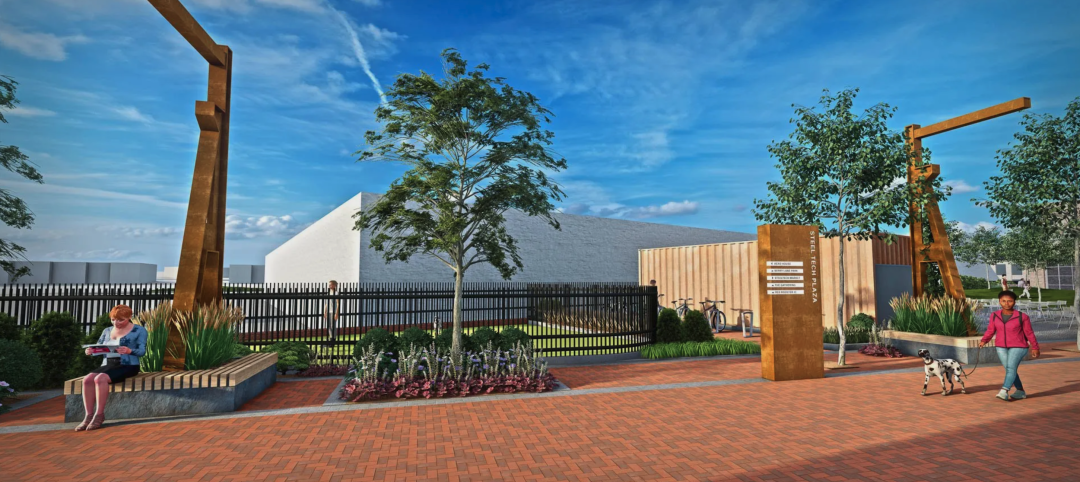In 2002, a couple of years before he died, Charles J. Pankow, Founder and Chairman of design-build firm Charles Pankow Builders, established a research foundation in his name. A pioneer in concrete-forming and moment-framing technology, Pankow was frustrated with the U.S. construction industry’s paltry support of research—a tiny fraction of 1% of revenues, compared to 11.1% of revenue for R&D in the health sector and 4.0% in the automotive, according to PwC’s 2015 Global Innovation 1000 report.
The biggest stumbling block to innovation in construction was (and is) lack of risk capital, due to sub-2% profit margins, says Richard “Rik” Kunnath, PE, Board President of the Charles Pankow Foundation (CPF). Add widespread reluctance among contractors to try anything new, coupled with the fragmentation of the AEC industry, and investing in R&D historically got short shrift.
The CPF wasn’t fettered by those restrictions. “As a nonprofit foundation, we could take risks that others could not,” says Kunnath. In 2006, the foundation started issuing grants, mostly to civil engineering profs at U.S. universities.
Results were mixed. Some of the research did lead to a few code tweaks and design improvements, but there were no breakthroughs. “We were washing the cleanest shirt in the laundry,” Kunnath admits. The foundation needed to concentrate its scarce resources where it could have the greatest impact.
Four years ago, Kunnath and Executive Director Mark J. Perniconi, PE, convened an advisory panel to identify where CPF-sponsored research could have the biggest bang for the buck.
Out of this strategic review came eight R&D initiatives that CPF would focus on (see list at left). It was a rigorous agenda, one that was very much in keeping with Charlie Pankow’s original intent: to cultivate innovation in design and construction and thereby “create buildings of improved quality, efficiency, and value.”
At the same time, the CPF board realized it could not change the AEC world on its own. It needed financial support from others. In recent years, the foundation has partnered with such entities as the ACI Foundation, the American Institute of Steel Construction (AISC), the Construction Industry Institute, the American Society of Concrete Contractors, and AEC firms Clark Construction Group, Magnusson Klemencic Associates, and Skanska USA Building.
Last year, CPF teamed up with 17 co-funders, whose investments leveraged its grant-making capability by 40-50%, says Kunnath. It was CPF’s biggest year ever: more than $2 million in grants. Let’s take a look at a few such efforts.
helping to MAKe INROADS ON BIM INTEROPERABILITY
CPF’s biggest investment—about $4 million—has been in BIM interoperability. “The SEs have their BIM software, the GCs have theirs, and the programs don’t speak to each other,” says Kunnath. CPF is supporting research at Georgia Tech to develop “translator codes” that will let the various BIM programs to talk to each other.
Out of that research came CPF’s Owners’ Guide to BIM Utilization. “It gives owners a good understanding of where BIM works, when to use it, at what level of detail,” says Kunnath. The guide has been adopted by the U.S. Army Corps of Engineers and others.
CPF has also supported BIM-M, a five-year program to encourage BIM use in masonry. It started when members of the Mason Contractors Association of America said they were being asked to bid projects using BIM. “Most had no idea how to do it,” says David Biggs, PE, SE, BIM-M Program Coordinator. “The steel and concrete people were well ahead of us in BIM.”
By the time the program sunsets next year, BIM-M will have invested about $2.2 million in R&D and BIM education for masons. “We’re supporting the development of plug-ins to make existing BIM software from Tekla and other vendors more useful to mason contractors,” says Biggs.
ENABLING STEEL AND CONCRETE R&D
Aiding research to make high-strength steel rebar a reality in the U.S. has been a major initiative. “U.S. codes don’t allow steel above 60 ksi, while the rest of the world is using 100 ksi steel,” says Kunnath. The HSS steel effort will take a decade and cost $10-15 million, but “in the end, we will have moved the U.S. into the modern era to make buildings cheaper and more globally competitive.”
CPF is partnering with AISC on concrete-filled composite plate shear walls. The three-year, $600,000 project (split evenly by CPF and AISC) will generate experimental data and numerical models leading to design guidelines for CF-CPSW core walls.
The research is being headed by Amit Varma at Purdue University. If successful, it would allow such core walls to be erected four stories at a time, using anchors and studs, with no rebar. AISC Vice President Lawrence F. Knuth, PE, says FEMA is adding $150,000 to the pot to test whether CF-CPSW walls could yield an R-value of R-8 for concrete (currently, R-6).
"We needed a new strategy. we were washing the cleanest shirt in the laundry."
Rik kunnath, PE, Charles Pankow Foundation
CPF is not alone in sponsoring AEC-related research. A number of architecture giants—Gensler, Perkins+Will, Perkins Eastman, CallisonRTKL, and GBBN, among others—routinely conduct research related to their work.
The AIA’s Academy for Architecture in Health Foundation has given $200,000 toward research in the last four years, notably for designing improved patient flow in emergency departments.
But the true catalyst for change in the construction sector has been the Charles Pankow Foundation. Since 2006, it has funded more than $12 million in research. The foundation recently pulled together a panel of 10 experts to codify best practices for high-rise construction in earthquake zones.
That initiative resulted in “Guidelines for Performance-based Design of Tall Buildings,” which details a peer-reviewed, rather than prescriptive, path for building in seismic zones.
THERE’S MORE TO COME
The foundation has been partnering with the Concrete Reinforcing Steel Institute on a multi-year project to gain industry consensus on performance specifications for high-strength rebar in seismic applications—data that will be used in modifications to the 2019 version of the ACI 318 building code.
The research is being conducted at multiple universities—Kansas and UT Austin among them—with technical help and materials donations in the $2-4 million range from steel mills and fabs.
“Having the partnership is crucial to getting all this research into practice,” says David McDonald, PhD, PE, FACI, the CRSI’s CEO.
“Research into practice.” That’s what the Charles Pankow Foundation is all about.
Related Stories
Hotel Facilities | May 2, 2023
U.S. hotel construction up 9% in the first quarter of 2023, led by Marriott and Hilton
In the latest United States Construction Pipeline Trend Report from Lodging Econometrics (LE), analysts report that construction pipeline projects in the U.S. continue to increase, standing at 5,545 projects/658,207 rooms at the close of Q1 2023. Up 9% by both projects and rooms year-over-year (YOY); project totals at Q1 ‘23 are just 338 projects, or 5.7%, behind the all-time high of 5,883 projects recorded in Q2 2008.
Multifamily Housing | May 1, 2023
A prefab multifamily housing project will deliver 200 new apartments near downtown Denver
In Denver, Mortenson, a Colorado-based builder, developer, and engineering services provider, along with joint venture partner Pinnacle Partners, has broken ground on Revival on Platte, a multifamily housing project. The 234,156-sf development will feature 200 studio, one-bedroom, and two-bedroom apartments on eight floors, with two levels of parking.
Mass Timber | May 1, 2023
SOM designs mass timber climate solutions center on Governors Island, anchored by Stony Brook University
Governors Island in New York Harbor will be home to a new climate-solutions center called The New York Climate Exchange. Designed by Skidmore, Owings & Merrill (SOM), The Exchange will develop and deploy solutions to the global climate crisis while also acting as a regional hub for the green economy. New York’s Stony Brook University will serve as the center’s anchor institution.
Market Data | May 1, 2023
AEC firm proposal activity rebounds in the first quarter of 2023: PSMJ report
Proposal activity for architecture, engineering and construction (A/E/C) firms increased significantly in the 1st Quarter of 2023, according to PSMJ’s Quarterly Market Forecast (QMF) survey. The predictive measure of the industry’s health rebounded to a net plus/minus index (NPMI) of 32.8 in the first three months of the year.
Sustainability | May 1, 2023
Increased focus on sustainability is good for business and attracting employees
A recent study, 2023 State of Design & Make by software developer Autodesk, contains some interesting takeaways for the design and construction industry. Respondents to a survey of industry leaders from the architecture, engineering, construction, product design, manufacturing, and entertainment spheres strongly support the idea that improving their organization’s sustainability practices is good for business.
Codes and Standards | May 1, 2023
Hurricane Ian aftermath expected to prompt building code reform in Florida
Hurricane Ian struck the Southwest Florida coastline last fall with winds exceeding 150 mph, flooding cities, and devastating structures across the state. A construction risk management expert believes the projected economic damage, as high as $75 billion, will prompt the state to beef up building codes and reform land use rules.
AEC Tech | May 1, 2023
Utilizing computer vision, AI technology for visual jobsite tasks
Burns & McDonnell breaks down three ways computer vision can effectively assist workers on the job site, from project progress to safety measures.
| Apr 28, 2023
$1 billion mixed-use multifamily development will add 1,200 units to South Florida market
A giant $1 billion residential project, The District in Davie, will bring 1.6 million sf of new Class A residential apartments to the hot South Florida market. Located near Ft. Lauderdale and greater Miami, the development will include 36,000 sf of restaurants and retail space. The development will also provide 1.1 million sf of access controlled onsite parking with 2,650 parking spaces.
Design Innovation Report | Apr 27, 2023
BD+C's 2023 Design Innovation Report
Building Design+Construction’s Design Innovation Report presents projects, spaces, and initiatives—and the AEC professionals behind them—that push the boundaries of building design. This year, we feature four novel projects and one building science innovation.
Mixed-Use | Apr 27, 2023
New Jersey turns a brownfield site into Steel Tech, a 3.3-acre mixed-use development
In Jersey City, N.J., a 3.3-acre redevelopment project called Steel Tech will turn a brownfield site into a mixed-use residential high-rise building, a community center, two public plazas, and a business incubator facility. Steel Tech received site plan approval in recent weeks.

















